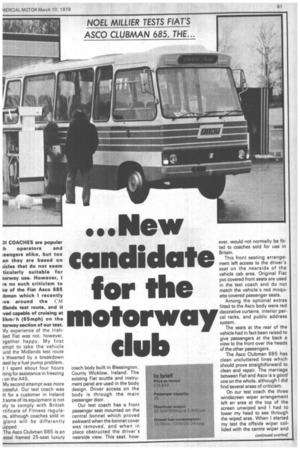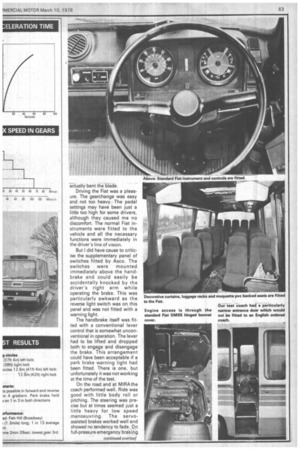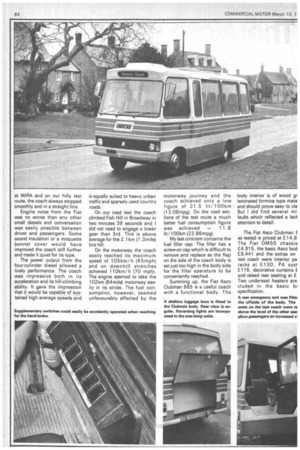...New candidate for the motorway club
Page 63

Page 65

Page 66

If you've noticed an error in this article please click here to report it so we can fix it.
31 COACHES are popular operators and isengers alike, but too en they are based on iicles that do not seem ticularly suitable for torway use. However, 1 re no such criticism to ke of the Fiat Asco 685 ibman which 1 recently lye around the CM cHands test route, and it .ved capable of cruising at 5km/h (65mph) on the torway section of our test. Vly experience of the I rishlied Fiat was not, however, 3gether happy. My first empt to take the vehicle und the Midlands test route s thwarted by a breakdown ised by a fuel pump problem, I spent about four hours iting for assistance in freezing on the A45.
My second attempt was more :cessful. Our test coach was It for a customer in Ireland some of its equipment is not ely to comply with British rtificate of Fitness regulans, although coaches sold in gland will be differently uipped.
The Asco Clubman 685 is an -steel framed 25-seat luxury coach body built in Blessington, County Wicklow, Ireland. The existing Fiat scuttle and instrument panel are used in the body design. Driver access on the body is through the main passenger door.
Our test coach has a front passenger seat mounted on the central bonnet which proved awkward when the bonnet cover was removed, and when in place obstructed the driver's nearside view. This seat, how ever, would not normally be fitted to coaches sold for use in Britain.
This front seating arrangement left access to the driver's seat on the nearside of the vehicle cab area. Original Fiat pvc covered front seats are used in the test coach and do not match the vehicle's red moquette covered passenger seats.
Among the optional extras fitted to the Asco body were red decorative curtains, interior parcel racks, and public address system.
The seats at the rear of the vehicle had in fact been raised to give passengers at the back a view to the front over the heads of the other passengers.
The Asco Clubman 685 has clean uncluttered lines which should prove straightforward to clean and repair. The marriage between Fiat and Asco is a good. one on the whole, although I did find several areas of criticism.
On our test coach the three windscreen wiper arrangement left an area at the top of the screen unwiped and I had to lower my head to see through the wiped area. When I started my test the offside wiper collided with the centre wiper and actually bent the blade.
Driving the Fiat was a pleasure. The gearchange was easy and not too heavy. The pedal settings may have been just a little too high for some drivers, although they caused me no discomfort. The normal Fiat instruments were fitted to the vehicle and all the necessary functions were immediately in the driver's line of vision.
But I did have cause to criticise the supplementary panel of switches fitted by Asco. The switches were mounted immediately above the handbrake and could easily be accidentally knocked by the driver's right arm while operating the brake. This was particularly awkward as the reverse light switch was on this panel and was not fitted with a warning light.
The handbrake itself was fitted with a conventional lever control that is somewhat unconventional in operation. The lever had to be lifted and dropped both to engage and disengage the brake. This arrangement could have been acceptable if a park brake warning light had been fitted. There is one, but unfortunately it was not working at the time of the test.
On the road and at MIRA the coach performed well. Ride was good with little body roll or pitching. The steering was precise but at times seemed just a little heavy for low speed manoeuvring. The servoassisted brakes worked well and showed no tendency to fade. On full-pressure emergency braking at MIRA and on our hilly test route, the coach always stopped smoothly and in a straight line.
Engine noise from the Fiat was no worse than any other small diesels and conversation was easily possible between driver and passengers. Some sound insulation or a moquette bonnet cover would have improved the coach still further and made it quiet for its type.
The power output from the four-cylinder diesel allowed a lively performance. The coach was impressive both in its acceleration and its hill-climbing ability. It gave the impression that it would be capable of sustained high average speeds and is equally suited to heavy urban traffic and sparsely used country roads.
On our road test the coach climbed Fish Hill in Broadway in two minutes 39 seconds and I did not need to engage a lower gear than 3rd. This is above average for the 2.1km (1.3mile) line hill.
On the motorway the coach easily reached its maximum speed of 105km/ h (65mph) and on downhill stretches achieved 110krn/ h (70 mph). The engine seemed to take the 102km (64mile) motorway easily in its stride. The fuel consumption, however, seemed unfavourably affected by the motorway journey and the coach achieved only a low figure of 21.5 lit/100km (13.08mpg). On the road sections of the test route a much better fuel consumption figure was achieved — 11.8 lit/100km (23.86mpg).
My last criticism concerns the fuel filler cap. The filler has a screw-on cap which is difficult to remove and replace as the flap on the side of the coach body is set just too high in the body side for the filler aperature to be conveniently reached.
Summing up, the Fiat Asco Clubman 665 is a useful coach with a functional body. The
body interior is of wood gr laminated formica type mate and should prove easy to ele But I did find several mi faults which reflected a lad, attention to detail.
The Fiat Asco Clubman E as tested is priced at £14,8 The Fiat 0M55 chassis £4,915, the basic Asco bod £9,441 and the extras on test coach were interior pa racks at £130, PA syst £116, decorative curtains E and raised rear seating at £ Two underseat heaters are eluded in the basic IN specification.




















































































































